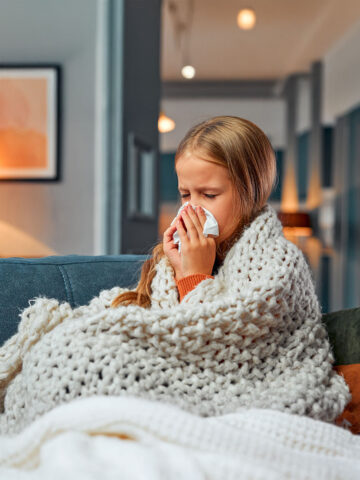Many families may plan to visit the pool or beach during the summer to swim on hot days. While the water is great for cooling off, if it gets stuck in your child’s ears, it can lead to a painful infection.
In this Q&A, Dr. Harry Pellman, a pediatrician in CHOC’s primary care network, advises parents on how to spot, treat and prevent swimmer’s ear.
My child is complaining that their ear hurts after swimming. Why is that?
It’s possible that your child may have developed swimmer’s ear (otitis externa), which is an infection of the external ear canal. Swimmer’s ear is most often caused by bacteria; it may also be caused by fungi. Water that stays in the ear canal during swimming, for instance, may let bacteria and fungi grow.
Swimming in lake and river water is more likely to cause swimmer’s ear because bacteria have difficulty growing in a chemically well-maintained swimming pool or the ocean water.
Children are more likely to get swimmer’s ear if they:
- Go swimming for long periods of time. This allows a better opportunity for the moisture to permit bacteria to grow.
- Fail to remove excess moisture after swimming. Keeping the ear canal dry helps keep the bacteria from growing. Having a narrow ear canal or ear wax inside both keeps the ear canal from drying out.
- Injure the ear canal with cotton swabs and other objects.
- Use hearing aids, earphones or swimming caps. These can all injure the lining and keep the ear canal from drying out well.
- Have skin irritation from allergies or other skin conditions sometimes makes it easier for the ear canal to get inflamed.
But you don’t have to swim to get swimmer’s ear. Anything that injures the skin of the ear canal can lead to an infection. Dry skin or eczema, scratching the ear canal, ear cleaning with cotton swabs, or putting things like bobby pins or paper clips into the ear can all damage the ear lining and increase the risk of otitis externa.
Rarely, if someone has a middle ear infection, pus collected in the middle ear can drain into the ear canal through a hole in the eardrum and cause it.
Learn the best way to clean a child’s earwax.
How can I prevent my child from getting swimmer’s ear?
There are a few ways to help prevent outer ear infections like swimmer’s ear. It’s all about keeping the inside dry and avoiding injuring the lining with instruments, cotton swabs, etc. Dr. Pullman suggests that parents encourage their kids to do the following:
- Wear removable, well-fitting earplugs when they swim to help keep the ear canals dry.
- Tip their head from side to side after getting wet to let the water drain out.
- Use a hair dryer on a low setting, at least 12 inches away, to dry their ears.
If their ears still aren’t drying out, talk to your doctor about using specified ear drops after swimming. These may help dry up the water in their ears and prevent infection.
How can I tell if my child has swimmer’s ear?
The main symptom of swimmer’s ear is ear pain. With swimmer’s ear, wiggling or tugging the earlobe can be very painful. It can also be severely painful when chewing and swallowing.
Hearing might be temporarily affected if pus or swelling blocks the ear canal. Most kids with swimmer’s ear don’t have a fever.
What does swimmer’s ear look like?
The outer ear may look red or swollen, and lymph nodes around the ear can get enlarged and tender. Sometimes, there’s discharge from the ear canal — this might be clear at first and then turn cloudy, yellowish, green and pus-like.
How do you get rid of swimmer’s ear?
The typical treatment for swimmer’s ear is prescription antibiotic drops. If a swollen ear canal makes it hard to put in the drops, the doctor may insert a tiny sponge called a wick to help carry the medicine inside the ear. In some cases, the doctor may need to remove pus and other buildup from the ear with gentle cleaning or suction. This allows the medication better access to the ear canal and lets the ear drops work better.
For more severe infections, health care providers may prescribe antibiotics taken by mouth and might want to run tests on discharge from the ear to find which bacteria or fungi are causing the problem.
Over-the-counter pain relievers like acetaminophen and ibuprofen often can manage ear pain. Once treatment starts, your child will start to feel better in a day or two. Swimmer’s ear is usually cured within seven to 10 days of starting treatment.
Will swimmer’s ear go away by itself?
Mild cases of swimmer’s ear may resolve on their own. But because of the discomfort and pain that swimmer’s ear may cause, most patients opt to get treatment from their doctor. Antibiotic drops are very effective for treating swimmer’s ear.
When should I see a doctor for swimmer’s ear?
Call your doctor if your child has any pain in the ear with or without fever, decreased hearing in one or both ears or abnormal discharge from the ear.
Does hydrogen peroxide help with swimmer’s ear?
Special hydrogen peroxide drops may help get rid of excess wax, but they may make swimmer’s ear much worse.
It’s important to check with your health care provider before using ear-drying drops after swimming. Do not use these drops if your child has swimmer’s ear, ear tubes, punctured ear drums or ear draining.
How often can you use swimmer’s ear drops?
Instructions for any prescribed ear drops or medications from your doctor will vary. Follow the health care provider’s instructions for using all medications.
It’s important to keep water out of your child’s ear during the entire course of treatment. You can use a cotton ball covered in petroleum jelly as an earplug to protect your child’s ear from water during showering or bathing.
How should you sleep with swimmer’s ear?
Sleeping with swimmer’s ear might be uncomfortable for kids. Try elevating their head with a couple of pillows and have them sleep on their non-infected side. This will help relieve any pressure on the ear and allow it to drain. Over-the-counter pain relievers might also help ease the pain.
For more health and wellness resources from the pediatric experts at CHOC, sign up for the Kids Health newsletter.
Find a CHOC Primary Care Pediatrician
From babies to teens, pediatricians from CHOC’s Primary Care Network partner with parents to offer immunizations, sick visits, sports physicals and more.






